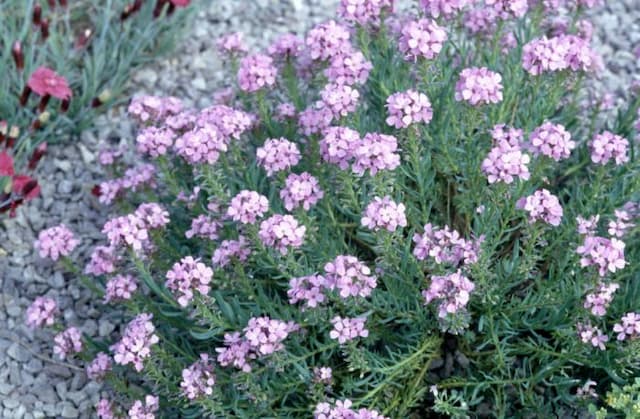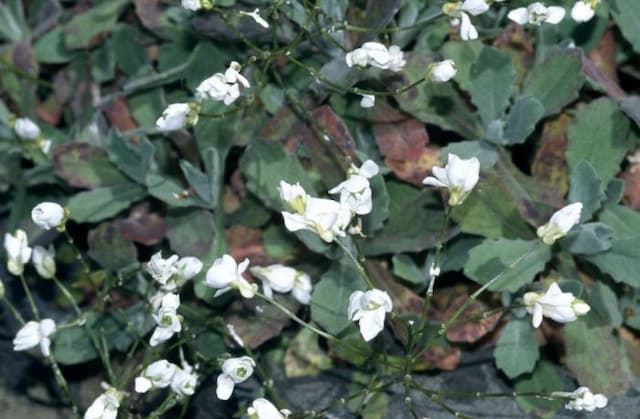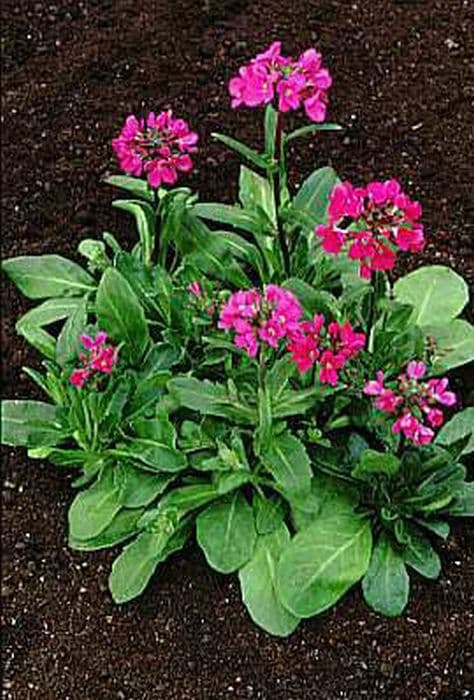Wallflower Erysimum Walberton's Fragrant Star = 'Walfrastar' (PBR) (v)
![wallflower [Walberton's Fragrant Star]](/_next/image?url=https%3A%2F%2Fplants-admin.emdemapps.com%2Fimages%2Fplants%2F%2Fimages%2F604b56c745877.png&w=3840&q=75)
ABOUT
The plant known as Erysimum Walberton's Fragrant Star 'Walfrastar' is an ornamental perennial that is highly valued for its aesthetic appeal and pleasant fragrance. It features a dense cluster of narrow, lance-shaped leaves that are a rich green color. These leaves create a lush backdrop for the plant's standout feature, its flowers. The blossoms emerge in abundant clusters, typically showing off a beautiful blend of colors ranging from creamy yellow to soft lavender, which can sometimes have a gentle gradient of colors on a single petal. Each individual flower within the cluster has four petals arranged in a cross shape, which is characteristic of its family. Moreover, the flowers emit a delightful scent that is most pronounced on warm, sunny days and in the evenings. These fragrant flowers not only add a visual charm to the plant but also attract pollinators such as bees and butterflies, which adds to the dynamism of any garden setting where the plant is situated.
About this plant
 Names
NamesFamily
Brassicaceae
Synonyms
Wallflower, Fragrant Star Wallflower, Walberton's Fragrant Star
Common names
Erysimum 'Walfrastar'
 Toxicity
ToxicityTo humans
The plant commonly known as Wallflower is not typically considered highly toxic to humans. However, like many plants, it may cause mild irritation or an allergic reaction if ingested or if the sap comes into contact with skin for some individuals. If ingested in large quantities, there could be more serious gastrointestinal upset. It’s always advisable to keep plants out of reach of children and to not consume any part of ornamental plants.
To pets
Wallflower is not commonly known for being highly toxic to pets. That said, it may cause mild gastrointestinal upset if ingested by animals, such as vomiting or diarrhea. As with humans, the best practice is to prevent pets from ingesting this plant, and if they do, monitoring them for any signs of illness and consulting with a veterinarian if any adverse symptoms appear.
 Characteristics
CharacteristicsLife cycle
Perennials
Foliage type
Evergreen
Color of leaves
Green
Flower color
Yellow
Height
1-2 feet (30-60 cm)
Spread
1-2 feet (30-60 cm)
Plant type
Shrub
Hardiness zones
6-9
Native area
Cultivar
Benefits
 General Benefits
General Benefits- Attracts Pollinators: The plant is known to attract bees and butterflies, which is beneficial for pollinating gardens.
- Aesthetic Appeal: 'Walfrastar' has brightly colored flowers that enhance the visual appeal of gardens and landscapes.
- Fragrance: It emits a pleasant fragrance, making it a popular choice for sensory gardens and outdoor living areas.
- Long Blooming: This variety typically has a long blooming period, offering colorful displays for much of the growing season.
- Drought Tolerance: Once established, it has good drought tolerance, making it suitable for xeriscaping or low-water gardens.
- Low Maintenance: Requires minimal care once settled in, making it an easy choice for both novice and expert gardeners.
- Versatility: Suitable for borders, containers, and rockeries, offering flexibility in garden design.
- Cold Hardy: It is quite resistant to cold temperatures, making it a sturdy perennial for many climates.
- Compact Size: With its compact growth habit, it is appropriate for small gardens or spaces where a smaller plant is desired.
 Medical Properties
Medical PropertiesThis plant is not used for medical purposes.
 Air-purifying Qualities
Air-purifying QualitiesThis plant is not specifically known for air purifying qualities.
 Other Uses
Other Uses- Artistic Inspiration: The Erysimum Walberton's Fragrant Star's vivid color and scent can inspire artists and photographers, making it an ideal subject for botanical illustrations and garden photography.
- Natural Dye: The petals of the Wallflower can be used to create a natural dye for fabrics, offering a sustainable way to color textiles with earthy tones.
- Educational Tool: Botany teachers may use the Wallflower to demonstrate plant growth, pollination, and life-cycle processes to students in a classroom setting.
- Culinary Garnish: Edible varieties of Wallflowers can add a splash of color and a hint of flavor when used as a garnish for salads and desserts.
- Garden Design: The Wallflower, with its compact shape and colorful blooms, is ideal for rock gardens, border fronts, or as a low hedge in formal garden designs.
- Companion Planting: This plant can be grown alongside vegetables in a kitchen garden to attract pollinators and improve crop yields.
- Aromatherapy: The scent from the Wallflower can be used in aromatherapy practices to create a calming environment in home or office spaces.
- Wildlife Habitat: When planted in the garden, the Wallflower provides nectar for bees, butterflies, and other beneficial insects, enhancing biodiversity.
- Fragrance Production: The flowers' aroma can be infused into oils and used in the preparation of perfumes and scented candles.
- Craft Projects: Dried Wallflower blooms can be used in potpourri or pressed flower projects, such as bookmarks and greeting cards.
Interesting Facts
 Feng Shui
Feng ShuiThe Wallflower is not used in Feng Shui practice.
 Zodiac Sign Compitability
Zodiac Sign CompitabilityThe Wallflower is not used in astrology practice.
 Plant Symbolism
Plant Symbolism- Resilience: Erysimum, commonly known as wallflower, often symbolizes steadfastness and the ability to endure challenging conditions, reflecting the plant's hardy nature and capacity to thrive in less than ideal environments.
- Faithfulness: Wallflowers are also associated with fidelity and loyalty due to their long-lasting blooms and the historical practice of wearing them to signify faithfulness to a loved one or cause.
- Adversity: The wallflower's habit of growing in the cracks of walls or cliffs lends it a symbolic meaning of overcoming adversity and finding a way to flourish despite obstacles.
- Perseverance: With its ability to bloom profusely and consistently, the wallflower is seen as a symbol of perseverance, representing the drive to continue and succeed over a prolonged period of time.
 Water
WaterThe Wallflower 'Walfrastar' requires consistent moisture, but it's crucial not to overwater. Water the plant when the top inch of soil feels dry to the touch, which typically means watering once or twice a week depending on the climate and soil drainage. It's best to water deeply and infrequently rather than little and often to encourage deep root growth. Provide the plant with about one gallon of water per session to ensure it reaches the root zone, adjusting for rainfall and temperatures, as plants in hotter areas may require more frequent watering.
 Light
LightWallflower 'Walfrastar' thrives in full sun to partial shade. To ensure the best growth and flowering, place it in a spot where it will receive at least 6 hours of sunlight per day. If you live in a region with very hot summers, some afternoon shade will help protect the plant from excessive heat.
 Temperature
TemperatureThe Wallflower 'Walfrastar' prefers temperatures ranging between 55°F and 75°F for optimal growth. It can survive minimum temperatures down to 20°F but should be protected from harsh winter weather. During hot summers, ensure the plant doesn’t get overheated if temperatures rise above 80°F, providing shade or extra water as necessary.
 Pruning
PruningPrune Wallflower 'Walfrastar' to encourage bushy growth and prevent the plant from becoming leggy. It's best to prune right after the main spring flowering has finished. Cut back the flower stalks by about one third, and consider a light trim again in late summer if necessary. Pruning is typically needed once or sometimes twice a year, depending on the plant's growth.
 Cleaning
CleaningAs needed
 Soil
SoilWallflower 'Walfrastar' prospers in a well-draining, fertile soil mix with added compost or well-rotted manure. The ideal soil pH for this plant is between 6.0 to 7.5. To create a suitable soil mix, combine equal parts of garden soil, compost, and perlite or coarse sand to ensure good drainage.
 Repotting
RepottingWallflower 'Walfrastar' is mostly grown as a short-lived perennial or biennial and so is not typically repotted often. If grown in containers, repot every 2-3 years in the spring using a soil mix as described above.
 Humidity & Misting
Humidity & MistingWallflower 'Walfrastar' thrives in moderate humidity conditions typically found in outdoor environments and does not require specific humidity adjustments for growth.
 Suitable locations
Suitable locationsIndoor
Place 'Walfrastar' in bright, indirect light and cool room.
Outdoor
Plant in sun, well-drained soil; protect from extreme cold.
Hardiness zone
7-9 USDA
 Life cycle
Life cycleErysimum 'Walberton’s Fragrant Star' typically starts its life cycle with seed germination, ideally in spring or early summer. The seedlings develop a root system and foliage as they mature into young plants. Once established, the plant enters a vegetative stage where it grows and forms a bushy structure with dense, gray-green leaves. The next stage is the flowering period, which usually occurs in late winter to spring, when the plant produces fragrant, star-shaped flowers. After pollination, the flowers develop into seed pods that, when mature, release seeds, completing the reproductive cycle. Lastly, as a perennial, Erysimum 'Walberton’s Fragrant Star' may enter a period of dormancy in winter before resuming growth in the following spring.
 Propogation
PropogationPropogation time
Spring-Early Summer
Erysimum Walberton's Fragrant Star, commonly known as Wallflower, typically propagates most successfully through softwood cuttings. This is often done during the late spring or early summer when the plant’s growth is most vigorous. To propagate Wallflower by cuttings, a gardener would select healthy, non-flowering shoots and cut them to about 3 to 5 inches (approximately 7.5 to 12.7 centimeters) in length, just below a leaf node. The lower leaves are removed and the cut end is dipped into a rooting hormone to enhance root development. The cutting is then placed in a well-draining potting mix, ensuring that the leaf nodes where the leaves were removed are buried as these areas are where roots are most likely to emerge. The cutting should be kept in a warm, humid environment, with indirect light until roots have established, and then it can be transplanted to its final location.






![Aubrieta [Axcent Burgundy]](/_next/image?url=https%3A%2F%2Fplants-admin.emdemapps.com%2Fimages%2Fplants%2F%2Fimages%2F604b5b7b548d8.png&w=640&q=75)


